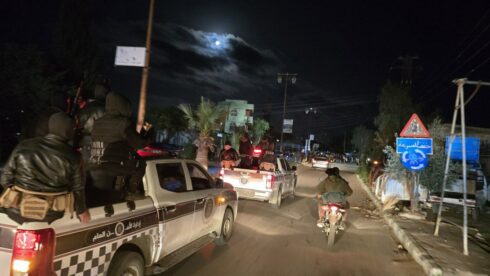Syria’s Islamist-led interim government imposed late on April 12 a curfew in the town of Busra in the eastern Daraa countryside following tensions with a powerful armed faction.
The tensions began on April 10 when clashes broke out in Busra between the General Security Service (GSS) and local fighters led by Ahmad al-Awda over an attack on Ahmed al-Daroubi, a former member of the faction who recently joined government forces.
Al-Daroubi died of wounds he sustained in the attack on April 11, and al-Awda was forced to accept an agreement with the government that saw the deployment of a large GSS force in Busra.
Despite the agreement with the government, more tensions were reported in Busra on April 12 as a result of violations by GSS personnel. Still, al-Awda didn’t pull out of the agreement, which reportedly requires all weapons in the town to be handed over to the government.
On April 13, the Syrian Observatory for Human Rights reported that two local fighters who attacked al-Daroubi were handed over to the GSS. The force also carried out a series of raids in Busra to seize weapons, but nothing was found, according to the London-based monitoring group.
Al-Awda led the rebel Youth of Sunna Forces between 2014 and 2018. In a surprise move, he reconciled with the Assad regime following the 2018 southern Syria offensive.
The commander was appointed the commander of the 8th Brigade of the Syrian Arab Army (SAA) 5th Corps, a formation primarily consisting of reconciled rebels, with backing from Russia. From 2021, he re-affiliated with the Syrian Military Intelligence.
As the SAA took heavy losses amid the 2024 Syrian opposition offensives, al-Awda and his forces defected back to the rebels. The commander spearheaded the attack on the capital, Damascus, toppling the regime of former president Bashar al-Assad.
Since the fall of the regime, Al-Awda has faced much criticism over his past ties to Russia and his strong relations with the United Arab Emirates. Now, the commander appears to be trying to avoid a confrontation with the government, all while maintaining his forces.
While the influence of local commanders in southern Syria like al-Awda appears to be on the decline, the government is yet to actually take control over the region due to threats from Israel.
The Israeli military has been operating in the region, mainly in the buffer zone adjacent to the occupied Golan Heights, since the fall of the Assad regime. Prime Minister Benjamin Netanyahu declared later in February that southern Syria, including Daraa, must be completely demilitarized, warning that Israel would not accept the presence of the forces of the new government close to its territory.
_______________________________________________________________________________________________________________________
SouthFront: Analysis and Intelligence
NOW hosted at southfront.press
Previously, SouthFront: Analysis and Intelligence was at southfront.org.
The .org domain name had been blocked by the US (NATO) (https://southfront.press/southfront-org-blocked-by-u-s-controlled-global-internet-supervisor/) globally, outlawed and without any explanation
Back before that, from 2013 to 2015, SouthFront: Analysis and Intelligence was at southfront.com







if trump and putin had not previously agreed to relocate gazans to syria and alawites to perm, this would not have happened. netanyahu would not tolerate jolani but would make awda the president of syria. putin and trump are the main causes of all this horror happening in syria. by the way, israel is not safe from erdogan’s criminal jolani, but netanyahu is so corrupt that he is willing to risk israel’s survival.
erdogan is great lead
blame putin! blame the pope! blame the leprechauns! just don;t blame the joos!
what joos ! who ? where ?
sohr = mi6.
“syrian government” = zio proxy cannibal head choppers.
al-colani is erdogans general.
general al -colani invited erdogan to rojova to free
rojova kurdistan with turkish army.
“as the saa took heavy losses amid the 2024 syrian opposition offensives” why does southfront engage in spreading such ignorant disinformation? this was not long ago and we all remember there were very little “losses” for the syrian arab army, there was only a massive, coordinated and pre-planned betrayal where the saa command ordered everyone to constantly retreat and avoid fighting cause they accepted bribes to abandon the legitimate president bashar al assad.
and what’s with this constant usage of the term “regime” in reference to the legitimate syrian government which was overthrown by al nusra and isis erdoganist terrorists? are these articles being written by cnn?
and if we give 1 star to this article it somehow still shows up as we gave it 4 stars? such sneaky deception only damages your reputation and credibility.
they won’t be asking you for a donation. 🙁